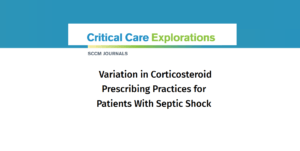Study Reveals Significant Variability in Corticosteroid Use for Septic Shock Across ICUs and Physicians
A study in Critical Care Explorations examined variations in corticosteroid prescribing for vasopressor-dependent septic shock across 26 ICUs in nine U.S. hospitals (2018–2020). Among 5,322 patients, only 24.3% received corticosteroids within two days of vasopressor initiation. Median ICU-level use was 21.8%, while physician-level use varied from 11.9% to 32.7%. Variability in prescribing was attributed 16.5% to ICUs and 10.1% to physicians. Corticosteroids can accelerate shock resolution but carry risks, leading to inconsistent usage. Guidelines recommend corticosteroids but allow flexibility, contributing to variability.
Researchers used electronic health records to link prescriptions to physicians, categorizing them into quartiles based on usage. Higher-use physicians prescribed at lower vasopressor doses. Sensitivity analyses confirmed trends over four days. Findings highlight excessive variation, suggesting a need for standardization. Multilevel interventions could improve adherence to evidence-based guidelines and patient outcomes.

Study Reveals Significant Variability in Corticosteroid Use for Septic Shock Across ICUs and Physicians
A study published in Critical Care Explorations examined variations in corticosteroid prescribing practices for patients with vasopressor-dependent septic shock. Researchers conducted a retrospective cohort study using electronic health records from 26 ICUs across nine hospitals in the United States between 2018 and 2020. They identified ICU patients with septic shock and analyzed whether they received corticosteroids within two days of vasopressor initiation. Patients were linked to their attending physicians through digital documentation signatures. A hierarchical mixed-effects logistic regression model was used to assess factors influencing corticosteroid administration and quantify variation at both the physician and ICU levels.
Among 5,322 patients with vasopressor-dependent septic shock, only 24.3% (1,294 patients) received corticosteroids within two days. Across 174 attending physicians, the median corticosteroid use at the ICU level was 21.8% (IQR: 18.5–25.7%), while at the physician level, it was 22.0% (IQR: 11.9–32.7%). The analysis revealed that 16.5% of the variation in corticosteroid administration was attributable to differences between ICUs, while 10.1% was linked to individual physicians. This variability highlights the need for multilevel interventions to standardize evidence-based treatment in critical care settings.
Septic shock, affecting around 10% of ICU admissions, has a high in-hospital mortality rate nearing 40%. Corticosteroids are one of the few treatments targeting the inflammatory response associated with organ dysfunction in septic shock. While research suggests corticosteroids may accelerate shock resolution and reduce short-term mortality, their benefits are modest and come with risks such as neuromuscular weakness, hyperglycemia, and superinfection. Current clinical guidelines recommend corticosteroids for vasopressor-dependent septic shock but acknowledge the trade-offs, allowing for significant practice variation among physicians. While some variability can be beneficial for individualized patient care, excessive differences in prescribing patterns may indicate missed opportunities to improve treatment consistency, reduce costs, and enhance overall patient outcomes.
To investigate this issue, researchers leveraged electronic health record metadata to link ICU patients to specific attending physicians, ensuring accurate attribution of prescribing decisions. The study assessed corticosteroid administration patterns, patient and physician characteristics, ICU factors, and vasopressor dosages standardized into norepinephrine equivalents. Physicians were categorized into quartiles based on corticosteroid use rates, and statistical analyses, including mixed-effects logistic regression, were conducted to determine the extent of variation at both the physician and ICU levels.
Results indicated that corticosteroid prescribing patterns varied considerably across physicians and ICUs, even when controlling for patient and provider characteristics. Physicians with higher corticosteroid use tended to prescribe them at lower vasopressor doses, though correlations were analyzed using Spearman rank coefficients. Additional sensitivity analyses examined prescribing behavior within a four-day window, confirming similar trends. The study’s findings underscore the importance of multilevel interventions to reduce unnecessary variability in septic shock treatment and improve adherence to evidence-based guidelines.
Check out TimesWordle.com for all the latest news
You must be logged in to post a comment.